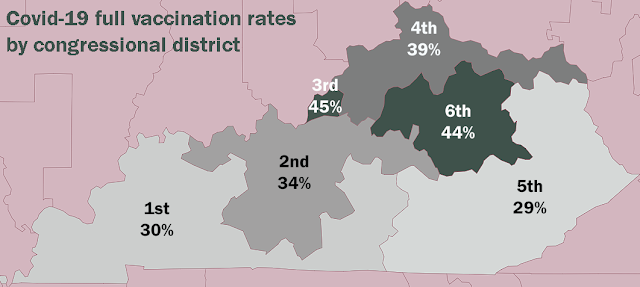Rural and conservative congressional districts, in Kentucky and the nation as a whole, have lower coronavirus vaccination rates

Map from Harvard University study; click here for the interactive version.
—–
More conservative and more rural Americans – and Kentuckians – are more likely to remain unvaccinated against the coronavirus, and the divide is growing.
“All but one of the 39 congressional districts where at least 60 percent of residents have received a coronavirus shot are represented by Democrats, according to a Harvard University analysis that presents one of the most detailed looks yet at the partisan split behind the nation’s diverging vaccination drive,” Dan Goldberg and Alice Ollstein report for Politico. “By contrast, Republicans represent all but two of the 30 districts where fewer than one-third of residents have received a shot.”
The 14 least fully vaccinated districts are all Republican and rural (or have a rural population of at least 40%). Missouri, which has one of the lowest vaccination rates of any state, took the bottom four spots. Appalachian Kentucky’s Fifth District shows up 38 spots up from the bottom, with 29.23% of residents fully vaccinated. The state’s next most rural district, the First, follows shortly thereafter with 29.82%.
As of June 1, Kentucky’s overall vaccination rate was 39.1%, the same as the nationwide average for metropolitan areas; among rural Kentuckians, the rate was 31.4%, just above the national rural average of 31.1%, Tim Murphy and Tim Marema report for The Daily Yonder. The Yonder, which has an interactive map with county-level vaccination data, notes that the nationwide metro vaccination rate is growing more quickly than the rural rate. Three weeks ago, the rural-urban vaccination gap was 7.2 percentage points, but two weeks ago it was 8 points.
The rural-urban gap stems partly from ideological sentiment, but also problems of access. “House members representing districts with low vaccination rates and public health experts, discussing their efforts to reach the unvaccinated, described what essentially has become two distinct conversations,” Goldberg and Ollstein report. “One is aimed at chipping away at vaccine hesitancy among conservative white Republicans, while the other is centered around reducing socioeconomic barriers to vaccination for poorer populations and communities of color.”
 |
| Screenshot from Harvard University study; for a larger version of the image, click on it. |